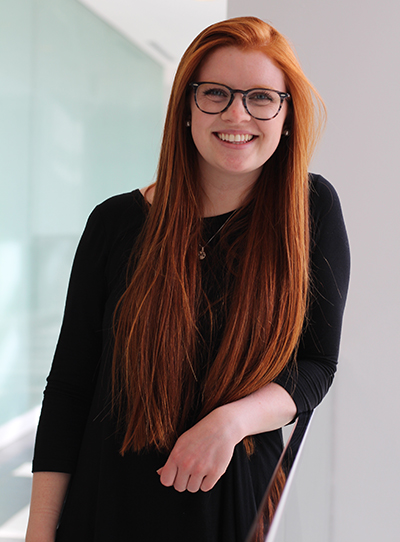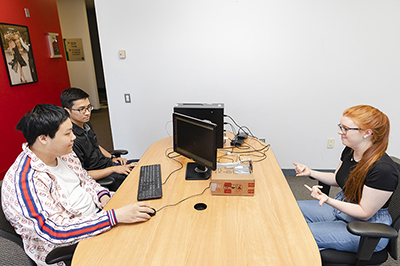Digital Interning
April 27, 2020
By Greg Sullivan
Therapeutic recreation student Riley Wilkerson was used to helping her clients overcome challenges every day as part of her internship in the sensory room of Fairfax County’s Providence Community Center.
But when the COVID-19 pandemic forced organizations like community centers to close their buildings, the 22-year-old got a chance to make some adjustments of her own.
“I can’t go to the actual room anymore for the internship,” Wilkerson said. “My special project was to teach an American Sign Language beginner class to the teams at the center, so now I’ve transitioned to writing out a very detailed plan for the class from home. So if someone picked up the binder I’m putting together and had a good understanding of sign language, they could teach the class after I’m gone and the building reopens.”

Another current project Wilkerson works on as she nears the completion of her 560-hour requirement for the internship is designing exercises, like hip workouts, and writing them out onto index cards. The idea is that, once the sensory room is open again, if a visitor shows up one day looking for ideas on what to do, they can pick up one of the cards and try out an exercise.
Aside from those projects, the senior from Fredericksburg is also staying busy digitizing client profiles and jumping into research and other work to help out the center, whose full-time staff has shifted their focus to pandemic-related work like distributing thousands of meals.
“Every day for work now I set up a space at home so I can focus while working remotely,” said Wilkerson, who will graduate in May. “I’ll typically start with going through my sign language program and laying out program ideas. Some days, I have a friend I’m teaching the program to as a trial class over Zoom. I’m checking email and checking in with my co-workers. And every day I’ll work on my portfolio—the end project for everything that’s done in the internship. It will be 30 to 40 pages when it’s done.”
Wilkerson’s advisor, Recreation Management Associate Professor Brenda Wiggins, said she’s been impressed with Wilkerson’s dedication to the center’s mission and how she’s worked well with the center’s team, many of whom are Mason alumni or adjunct faculty in the department.

“I’m proud of Riley’s ability to work independently on her special project while contributing content for many important endeavors. She is proving her flexibility and course knowledge toward future positions,” Wiggins said.
Positive effects from sensory rooms
Sensory rooms are designed to be relaxing and calming environments that offer sights, sounds, and interactive elements that promote stress-free engagement and physical and intellectual development. The Providence Community Center’s state-of-the-art sensory room, located on the center’s second floor, features special lighting and sounds (such as the trickling of water), touch screens, touch/texture wall boards, a floor piano mat, and musical chairs.
Wilkerson said that visitors to the room have ranged in age from 9 months to 70.
“It’s good for people on the spectrum—people with disabilities benefit from it, but anyone can benefit from it,” she said. “It’s a good place to work on attention span and paying attention to different things.”
Some other populations that visit frequently, Wilkerson said, are people with Alzheimer’s disease, early onset dementia, intellectual disabilities, developmental disabilities, sensory processing disorder, those who were born premature, and those suffering from anxiety.

Wilkerson said she’s disappointed for the many who use the room regularly who aren’t able to use it right now. While she said online sensory rooms wouldn’t really work, she and the staff have talked about coming up with some do-it-yourself sensory projects their clients can do at home.
“You can make sensory things in your house really easily,” she said. “Aluminum foil, a bowl of rice, lay out a bunch of blankets.”
Following her passion
This wasn’t an internship that Wilkerson sought out on a whim; it’s part of what has been a life mission.
Starting when she was 5 years old, her parents placed her in an inclusion class where typically developing kids interacted alongside individuals with disabilities. She also currently serves as a caregiver for two individuals with Down syndrome and one with autism.
While at Mason, she completed a practicum with an ABA (applied behavioral analysis) therapist for her major practicum requirement and has worked with Mason LIFE as a community integration liaison, planning outings for group participants to attend events like the National Cherry Blossom Festival and Washington Capitals games.
While some of her initial post-graduation plans are on hold, Wilkerson said she’s considering pursuing graduate studies in the coming years in occupational therapy and will perhaps work part time as an American Sign Language interpreter on the side of a future job in her field.
While she knew she wanted to work with people with disabilities, the sensory room internship was something unexpected because it wasn’t in a school classroom or in a clinical environment.
“This internship definitely showed me that there’s a lot more opportunity in my major than what I anticipated of where I could take my focus,” Wilkerson said. “I always wanted to [work with people with] disabilities, but now I’m seeing there are so many different ways to do this and make a difference in the community.”
